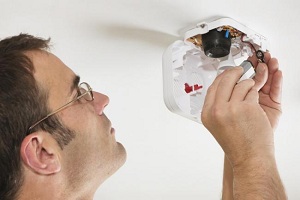The Scottish Government has introduced new fire safety laws legislating that all homeowners be required to have interlinked alarms in their properties. The move, which the Government has set aside £15million of loan funding aimed at social housing landlords, is designed to significantly reduce casualties by alerting everyone in a property to the event of a fire. A campaign is currently underway to promote the message to property owners, with the changes becoming law from February 2022.
Private rented and new-build homes are already required to meet these standards, but they will apply to every home in Scotland, regardless of age or tenure, from February.
Housing Secretary Shona Robison said: “One death from a house fire is one too many, and improving fire safety remains our utmost priority. In February, Scotland will become the first UK nation to require every home to have interlinked fire alarms, which significantly reduce the risk of injury or death. If there is a fire in one room it will set off alarms throughout the property, giving residents more time to escape.
“Homeowners are generally responsible for paying for works to protect their property, but we know some may not be able to meet the cost of fitting these alarms. That is why we are providing £500,000 to help disabled and older people, on top of the £1 million we have already provided to the Scottish Fire & Rescue Service to install alarms in owner-occupied homes identified as being at highest risk.”
By February 2022, every home in Scotland will need to have:
• One smoke alarm in the room you spend most of the day, usually your living room
• One smoke alarm in every circulation space on each storey, such as hallways and landings
• One heat alarm in the kitchen
• All smoke and heat alarms should be mounted on the ceiling and be interlinked
• If you have a carbon-fuelled appliance, like a boiler, fire, heater or fuel you must also have a carbon monoxide detector. This does not need to be linked to the fire alarms.
The two types of interlinked fire alarms that meet the new rules are sealed battery alarms (tamper-proof), or mains-wired alarms (should be installed by a qualified electrician). Both are interlinked by radio frequency without the need for WiFi. Alasdair Perry, Head of Prevention and Protection at the Scottish Fire and Rescue Service, added: “Having the earliest possible warning of a fire in the home can and has saved lives and property. Having interlinked alarms installed will allow everyone, anywhere in the house to take action as quickly as possible.
“The Scottish Government has provided financial support to our Home Fire Safety Visit programme, which will allow us to fit to the new standard in the homes of those identified through our robust criteria as being at higher risk. However, if we go to any property that has no detection, we will still provide a battery-operated stand-alone smoke detector and advise the occupant about the new standard for the fire and smoke alarms required by the legislation in all Scottish homes.”








